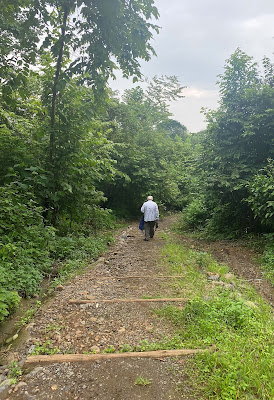March 28, 2022
After hours of winding roads and then dirt roads, which were hard on me but didn't seem to affect anyone else (I'm so wimpy), we finally made it to our last destination of the trip, the Charute Mangroves Ecological Reserve and Cocoa Farm. The Ecological Reserve covers about 220 square miles, and is about 25 miles from the city of Guayaquil.
.png) |
| Map adapted from one found here |
We stopped first at Hacienda Cacao & Mango, a farm focused on agritourism.
Our first item of business was a stop at the WC. I don't usually mention that in posts, but this one was extra cute.
I didn't get pictures of all the lunch courses (and I forgot to write down what we had), but I have these two photos of what I recall as being okay empanadas and chocolate tarts where the chocolate filling was wonderful and the shell was dry and thick.
We had a little time to enjoy the tropical flora and fauna . . .
. . . before we began to learn about cacao production for the third time on this trip. (They take the cacao industry very seriously in Ecuador.) However, it was the first time we were standing in an actual cacao grove learning from a farmer. He obviously knew what he was talking about. Javier told us that the farmer had studied some biology, but hadn't graduated from college. I definitely came across as well educated.
He explained the different kinds of cacao. The "national" cacao is about 20% of their crop. It takes the longest to grow and is much higher quality than the rest. That is the bulk of what they export. It is the yellow bean on the right below. The farmer told us that the cacao takes on the flavor of the plants that grow around it, which is why you can taste the difference in fine chocolate from different countries.
He walked us through the fermenting, roasting, and grinding process.
This panorama of beans from the original state all the way through to the liquid state is a work of art.
This is what pure ground cacao looks like:
The ground cacao is whipped by machine for quite a while to refine it, I think it may have been a few days, before it is turned into a chocolate bar.
The chocolate production part of the farm is run by a married couple. She handles the marketing, and he handles the bean-to-bar production. Here he is cooling the chocolate to an exact temperature on a chilled surface.
The last step is to put the chocolate in molds to make bars. Well, actually, the VERY last step is to eat some. Yum!
He was the Pied Piper of Ecuador. This is one of my favorite photos of the trip.
This is what he was taking photos of: the Pacific parrotlet.
Back on the road, we drove through a few streams, some bigger than this one.
An extensive network of canals and islands is formed when the salty ocean meets and mixes the fresh water from multiple rivers.
We motored upstream in a wide, glassy river that didn't seem to have a current. Both banks were heavy with mangrove forests, and we could both see and hear a lot of birds. I sat in about the middle of the canoe, with Bob in front and our friends behind me.
Bob likes the front where he has a better chance of taking some bird photos.
These are two of my favorite of his photos. The first is of a tree full of roseate spoonbills.
And this is a white ibis.
We eventually turned around, made it back to the van, drove back down the bumpy dirt road and through a few significant streams crossing the road, and--hallelujah!--to a paved highway that led to the Guayaquil Airport and the Sheraton Hotel, where we caught a few hours of sleep and had a much needed shower before catching a shuttle at 1:00 AM to the airport.
Check-in was uneventful, and we spent some time wandering in the shops. I bought a red glazed ceramic angel, but that was it.
The flight to Panama City was less than two hours, and the airport there was just as awful as it was on our visit a few weeks before. Nothing was open, and the best I could do for breakfast was a can of Coke. The flight to LAX was 6.5 hours, and then we had the shuttle to the car and the 1.5 hour drive home. It was a long day.
All in all, it was quite an incredible trip with an amazing amount of variety, from large cities like Quito and Cuenca to outposts like Mindo to the wild outreaches of the Galapagos Islands. As always, it is hard to believe that we were there. I'm grateful for this way of keeping records so that we can go back and relive our journeys.







.JPG)




.JPG)






.JPG)






.JPG)
















It was my first time seeing the chocolate process and I learned a lot. I learned that the white sack around the bean is the best part - just it eat and throw the rest away - sweet and wet. It was a different Ecuador than we'd seen, a jungle Ecuador.
ReplyDelete